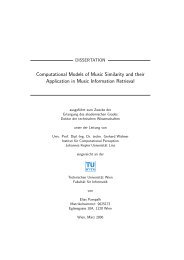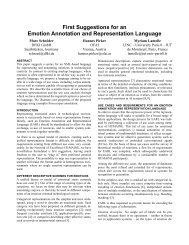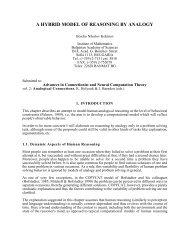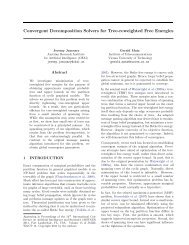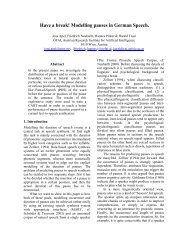Global Musical Tempo Transformations using Case Based ... - OFAI
Global Musical Tempo Transformations using Case Based ... - OFAI
Global Musical Tempo Transformations using Case Based ... - OFAI
You also want an ePaper? Increase the reach of your titles
YUMPU automatically turns print PDFs into web optimized ePapers that Google loves.
From the resulting set of rules, the rules that have the highest percentage of<br />
correct predictions are selected. In this way the obtained rule set consists of<br />
a modest number of rules that all have a reasonable degree of generality.<br />
The rules that are learned are conditional rules by PLCG, consisting of<br />
a set of conditions (with and/or relations), that refer to the score, and an<br />
action that is to be performed if the conditions are met. The actions refer<br />
to the timing, dynamics and articulation of notes. They are not quantitative<br />
but qualitative (actions can for example be ‘lengthen note’, or ‘play louder’).<br />
An example of a rule that was discovered is:<br />
lengthen IF<br />
next dur ration < 1 &<br />
metr strength ≤ 2<br />
which should be read as “Lengthen a note if it is followed by a longer note<br />
and if it is in a metrically weak position.”.<br />
The models predicted in this way are partial models based on the note<br />
level, so they leave opportunity for predicting regularities at higher structural<br />
levels by other means. Widmer [120] used this opportunity by predicting<br />
higher level regularities such as crescendo/decrescendo and<br />
accelerando/ritardando <strong>using</strong> another machine learning approach, called Nearest<br />
Neighbor Learning (NN). To achieve this, the performances that serve as<br />
experience, are analyzed in terms of tempo and dynamics. Both tempo and<br />
dynamics curves of the performances are fitted by quadratic functions iteratively<br />
(in each round a function is fitted to the residual of the previous<br />
round). These functions are stored for each performance. To predict the<br />
tempo and dynamics of a new score, the tempo and dynamics functions of<br />
the most similar ‘learned’ scores are taken. The similarity between scores is<br />
taken as the Euclidean distance between a vector of musical attributes.<br />
When the NN algorithm for predicting phrase level performance phenomena<br />
is combined with the PLCG algorithm for predicting note level phenomena,<br />
a composite and complete model emerges that predicts better than<br />
either model alone.<br />
ÖFAI’s machine learning approach to machine performance of music as<br />
just described is currently one of the most advanced approaches in the field.<br />
This is confirmed by the fact that there performance rendering system has<br />
won the second prize at the 2002 RenCon Contest for machine rendering<br />
of piano music. Nevertheless, Widmer notes some limitations and room for<br />
improvement. The polynomial curve fitting seems to be more promising for<br />
predicting dynamics than for tempo. The performance of the system could<br />
also benefit from a richer representation language. Furthermore, possible<br />
23




